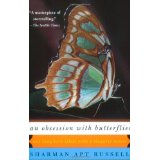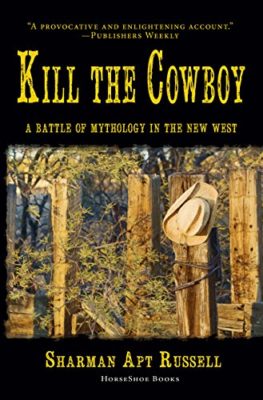Diary of a Citizen Scientist: Chasing Tiger Beetles and Other New Ways of Engaging the World
In the exploding world of citizen science, hundreds of thousands of volunteers are monitoring climate change, tracking bird migrations, finding stardust for NASA, and excavating mastodons. The sheer number of citizen scientists, combined with new technology, has begun to shape how research gets done. Diary of a Citizen Scientist is a timely exploration of the phenomenon of citizen science, told through the lens of nature writer Sharman Apt Russell’s yearlong study of a little-known species, the Western red-bellied tiger beetle. In a voice both humorous and lyrical, Russell recounts her persistent and joyful tracking of an insect she calls charismatic, elegant, and fierce. Patrolling the Gila River in southwestern New Mexico, collector’s net in hand, she negotiates the realities of climate change even as she celebrates the beauty of a still-wild and rural landscape.
More info →Standing in the Light: My Life as a Pantheist
"Everything is connected, and the web is holy.” So wrote Marcus Aurelius, the starting point of Sharman Apt Russell’s wise and haunting new memoir about her life as a pantheist. Here she explores the history of this tradition from the Stoic philosophers to the Transcendentalists while reflecting on her own life during a year spent in the mountains and desert of southwestern New Mexico. Nature provides the inspiration for meditations on subjects ranging from Buddhist thought to the death of her father, from global warming to the ineffable loneliness of human experience. With a humane heart, an inquisitive mind, and an astounding fluency of prose, Sharman Apt Russell invites skeptics, scientists, and seekers everywhere to join her in her exploration of the soul of pantheism.
More info →Hunger: An Unnatural History
Every day, we wake up hungry. Every day, we break our fast. Hunger is both a natural and an unnatural human condition. In Hunger, Sharman Apt Russell explores the range of this primal experience. Step by step, Russell takes us through the physiology of hunger, from eighteen hours without food to thirty-six hours to three days to seven days to thirty days. In quiet, elegant prose, she asks a question as big as history and as everyday as skipping lunch: How does hunger work?
More info →An Obsession with Butterflies: Our Long Love Affair with a Singular Insect
Butterflies have always served as a metaphor for resurrection and transformation. In this lyrical meditation, Sharman Apt Russell reveals the logic behind our endless fascination with butterflies and introduces us to the legendary collectors and dedicated scientists who have obsessively cataloged new species of Lepidoptera. A luminous journey through an exotic world of passion, biology, and beauty, this is a book to be treasured by anyone who has ever experienced the enchantment of butterflies.
More info →Anatomy of a Rose: Exploring the Secret Life of Flowers
In Anatomy of a Rose, Sharman Apt Russell eloquently unveils the "inner life" of flowers, showing them to be more individual, more enterprising, and more responsive than we ever imagined. From their diverse fragrances to their nasty deceptions, Russell proves that, where nature is concerned, "wonder is not only our starting point; it can also be our destination." Throughout this botanical journey, she reveals that the science behind these intelligent plants--how they evolved, how they survive, how they heal--is even more awe-inspiring than their fleeting beauty. Russell helps us imagine what a field of snapdragons looks like to a honeybee; she introduces us to flowers that regulate their own temperature, attract pollinating bats, even smell like a rotting corpse.In this poetic rumination, which combines graceful writing with a scientist's clarity, Russell brings together the work of botanists around the globe, and illuminates a world at once familiar and exotic.
More info →When the Land was Young: Reflections on American Archaeology
Archaeology is a tale of peopling that in North America extends our cultural perspective back at least twelve thousand years, a story that Sharman Apt Russell brings to vibrant, contentious life. A history of archaeology in America, written with clear-eyed wit and grace, Russell's book takes the study of our ancestors out of the museum and shows us the immediate, human implications of our forays into the past. Whether exploring the theory that humans caused the extinction of Pleistocene mega-fauna, or the demands for the repatriation of Native American remains, or the meaning of burial mounds in Ohio, Russell keeps in clear view the idea that there are multiple ways of examining the past. She interviews an array of characters who have been instrumental in reshaping modern archaeology and speaks to those, such as Pawnee activists fighting for the return of ancestral remains or a Navajo archaeologist at odds with his people's prohibition against handling the dead, who continue to wrestle with the nature and practice of archaeology today.
More info →Kill the Cowboy: A Battle of Mythology in the New West
Rising larger than life against the Western horizon, the cowboy sits astride his horse right in the middle of American mythology, husbanding our ideals of freedom, independence, and valor. And grazing his cattle on the wide-open land, he leaves a dusty trail: weeds spring up, scrub brush flourishes, wildlife declines, ground compacts, soil erodes, streambeds turn into gullies. Treading a fine line between the idyllic myth and the harsh facts of real-life ranching, this book offers a measured look at the struggle over the future of the American West, where visions of the land sharply divide between those who want to use it, those who want to save it from abuse, and those who see a middle way.
Fairly—envisioning a revamping of the current grazing system—Sharman Apt Russell describes the present battles that pit ranchers against environmentalists, new Westerners against old, private concerns against government policies. The story she tells is dramatic, animated with the distinctive personalities and contentious episodes that have shaped current debates. It is also scrupulously attentive to the details of history, politics, and economics in the region. Grounded in a deep respect for land, this elegantly written, well-reasoned book begins the work of reevaluating our heroic myths and immediate needs in a way that will prove sustainable for all the West's inhabitants.
Songs of the Fluteplayer: Seasons of Life in the Southwest
Songs of the Fluteplayer won the Mountains and Plains Booksellers Award and New Mexico's Zia Award for its lyrical descriptions of the charm and challenge of the spectacularly beautiful American Southwest. Sharman Apt Russell and her husband moved to the Mimbres Valley in southwestern New Mexico in order to lead a simpler yet more substantial life. Their efforts to be self-sufficient--building an adobe house, giving birth at home, growing their own food--shattered many ideals and forced compromises but also renewed their ties to each other and kindled their respect for the land and its people. The American Southwest that Russell fell in love with comes to life vividly in her writing. From Navajo weavers to illegal Mexican workers, trading posts to prehistoric pottery, water rights disputes to the omnipresent fluteplayer Kokopelli--the energy and wonder of the Southwest is celebrated in this enchanting book.
More info →











